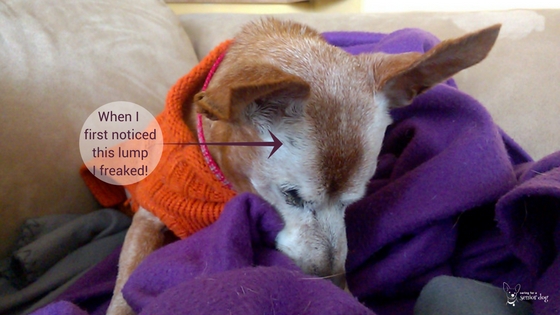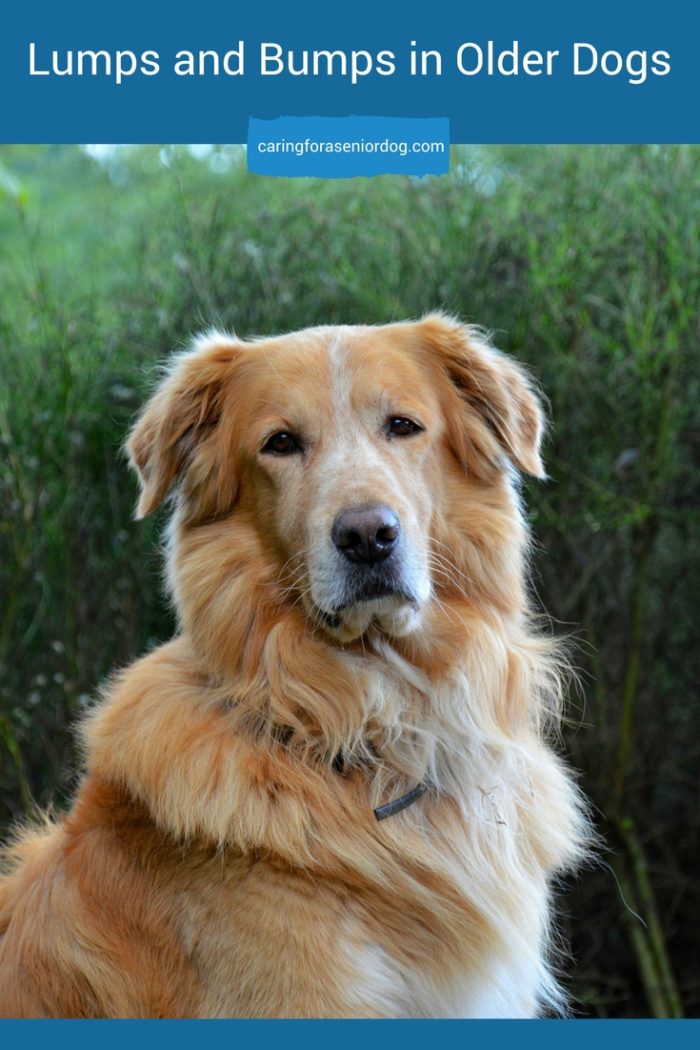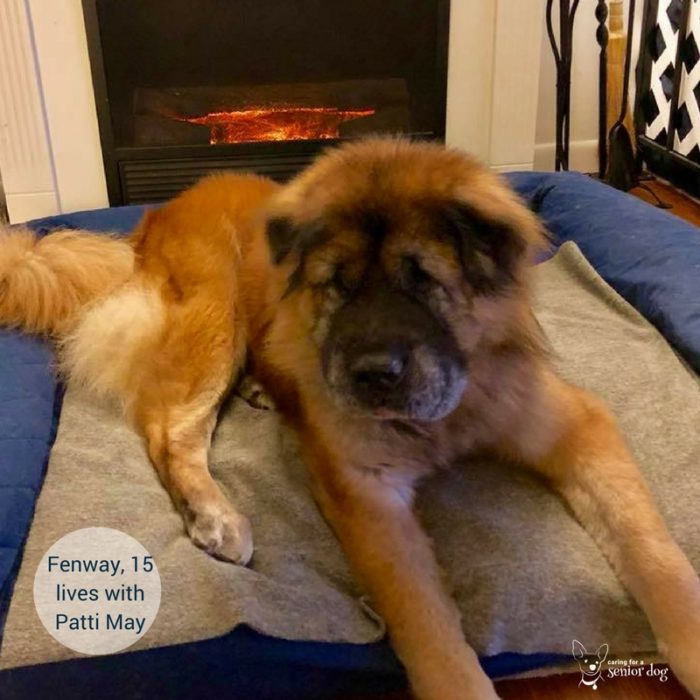
Lumps and bumps in dogs are not unusual, and most of the time, they are nothing to worry about.
You know when you’re sitting on the couch relaxing, slowly petting your dog, and then you feel a lump? You heart skips a beat, you get that nauseous feeling, and the word “cancer” fills your every waking moment.
I do!
The good news is that most lumps are just fatty tumors, benign and nothing to worry about.
I think that’s very encouraging, but I also strongly advise you to get it checked sooner rather than later. It will put your mind at ease, an the earlier something is caught, the better the chances of curing or at least managing it.
Last Updated: May 30, 2023

Most lumps found in senior dogs are lipomas or fatty tumors
The most common lumps are called lipomas or, as the layperson refers to them, “fatty tumors.” They are masses under the skin and a natural part of aging.
Most of the time, nothing needs to be done about lumps and bumps in dogs.
However, they can grow larger and, depending on where they’re located on the body, may cause problems such as impeding movement.
If a dog has one mass, they will likely develop multiple masses. Although there’s a good chance it’ll be benign, all fatty tumors in dogs should be checked just to be sure.
Infiltrative lipomas invade muscle tissue and may need to be removed.
Liposarcomas are malignant and can spread to the bone or other organs. Although rare, they do happen, which emphasizes the importance of checking each new mass that develops.
Some prep work before the appointment
There are steps you can take to help provide your vet with the best chance of identifying the cause of your dog’s lumps. This will help them catch any issues early, improving the chance that they can be treated effectively.
To help give your vet a full picture of the situation, beyond just what they see at the appointment, provide the following information:
- When did you first notice the lump?
- Have you felt or seen a change in size, color, or shape?
- How long has he had it?
- Has your dog exhibited any changes in behavior lately – eating habits, sleeping more, restless, lethargic…
What can you expect at your appointment?
During the appointment, your vet will use a very fine needle to remove some cells to see under the microscope in the office.
He may be able to diagnose it immediately. Otherwise, a sample will be sent to a lab for analysis by a pathologist.
It usually takes a few days for results unless there’s a cause for concern, and he may be able to put a rush on it.
If those results are inconclusive, surgical removal of the mass may be required for a more thorough analysis.
Waiting can be tough
I know how tough waiting can be, and I know you think it’s easy for me to say not to jump to conclusions and assume the worst. But I’ll say it anyway.
Most lumps in dogs are benign.
As a matter of fact, I was at the local vet the other day and bumped into a neighbor with her elderly dog. She had found a lump and was there to get the biopsy results, which were fortunately benign.
Treatment options
Your vet may have already booked you for an appointment to discuss results or will call you. Either way, based on those results, he will have decided on the best course of action.
If the lump is benign, there isn’t usually a reason to remove it unless it is causing your dog discomfort or restricting movement.
Of course, if it turns out to be cancer, the concern will be if it has spread to other parts of the body.
A CT or MRI may be needed to get a clearer picture of the mass and its location. Surgery, chemo, radiation, or all three may be necessary.

To remove a lump or not?
Some vets will remove them (the woman I mentioned earlier did have her dog’s lump removed), while others prefer to adopt a “wait and see” attitude.
This can be for several reasons, including the location of the lump and the dog’s age and medical condition.
In her post “Why I Don’t Remove Lipomas – Unless They Do This,” Dr. Karen Becker goes into detail about this decision process and the factors that she considers.
Keeping on top of things
If your dog has lots of lumps and bumps (I’ve known quite a few old dogs like that), your vet will want to keep track so he can quickly find any new ones or recognize changes in existing ones.
A chart of their locations is the way to do that.
Through regular grooming, massage, and petting sessions, you will be quickly aware of any changes to the size and shape of existing lumps and the development of new ones.
When should I be concerned about my dog’s bumps?
While most bumps in dogs aren’t a serious cause for concern, there are some warning signs that you should watch out for.
This includes:
- Fast or excessive growth of the lump
- Redness
- Swelling
- Pus or discharge
- Opening of or damage to the skin
- Signs your dog is in pain
If you notice any of these signs, you should contact your vet as soon as possible.
This doesn’t mean that you have discovered a dog tumor and your dog for sure has cancer – but it could be a sign of something that needs to be addressed.
For example, an open wound could lead to infection, causing pain and discomfort that is completely unrelated to any form of cancer.
An alternative point of view
I’m very interested in alternative medicine, both for myself and my pets.
I recently came across a truly fascinating article in Dogs Naturally Magazine that discusses the various causes of lipomas and offers natural treatment options.
It includes insights from experts like veterinary immunologist Ronald D Schultz PhD. I recommend you set aside time to read it.
Conclusion: Lumps and bumps in dogs
There’s a lot of good news in this article, don’t you think?
Most lumps and bumps in older dogs are nothing to worry about, and from a holistic point of view, there’s a lot we can do to address them quickly and effectively.
If your dog does have bumps already, you should track and record their location and approximate size. This will help you monitor for any changes that could indicate they are something to be concerned about.
If you notice any signs of pain, swelling, discharge, or damage to your dog’s skin, contact your veterinarian to discuss your options.
The sooner your vet identifies the cause, the better the chance that it can be treated or managed to give your dog the long, happy life that they deserve!


 Dog Incontinence Products
Dog Incontinence Products
We just went through this with our oldest dog, Miley who is 8 years old. Found a lump last week and she had it removed yesterday. It certainly took me by surprise but we are remaining hopeful for good news next week.
I’m sorry to hear that, but lucky you found it when you did and it’s out. I do hope you get good news next week. Let me know.
Lumps and bumps have always scared me. Even though lots of them are nothing, until we know that for sure, I get so worried if I see one!
I know what you mean Jenna. When I saw that tiny little bump on Red my first instinct was to panic. Luckily it was nothing but you’re right, we panic until we know.
We have blogged quite a bit about dog lumps and bumps. As a dog mom who had a Cocker with a bump that ended up being cancer, we are super diligent about any new growth. Off to the vet for aspiration is our rule.
That’s a great rule to have. Hopefully you noticed the bump quickly. One day I was petting one of my cats and discovered a huge lump in his neck. I pet him all the time, there’s no way that thing was there long. I immediately took him to the vet and that was cancer as well. Now I’m even more crazy diligent than before.
My own dog, Soldier, will be eighteen years old next month and has so many fatty tumors that we’ve taken to affectionately calling him “Lumpy Boy.” Fortunately, his vet says they are all benign and don’t require removal. The veterinarian said that at Soldier’s age and with his enlarged heart, the anesthesia would be more dangerous than the lumps. So we continue to carefully monitor them and consult with his veterinarian. So far, no pain or discomfort.
And thank you for writing a blog that focuses on senior dogs – senior pets are my special passion, and your information is so helpful for senior pet owners.
Hi Lori, how wonderful you’re still sharing your life with Soldier at 18!! Great news that his lumps are nothing to be concerned about. Even though anesthesia is safer these days, why take a risk if there’s no benefit. Thanks I’m glad you think the information is helpful. I can’t stand the way seniors are viewed, so I’m making it my mission to change perception. They’re my passion too and I wish I was able to take more home. I’ve just been fostering 2 young dogs and while I’m thrilled I have found them homes, I don’t get that same “soul satisfaction” as when I bring an old dog home.
My dog is 17 nearly 18 years old and suddenly got lumps Everywere stomach , sides , even pea size lumps on paws and hot lumps in his mouth he’s going blind and starting to lose his hearing I’m so scared they will put him asleep coz he so old but I don’t won’t him to be in pain he does let us touch lumps and bumps but at times he will cry wen asleep I’m so worried but I don’t won’t him in pain he is my little old man can someone help me decide wat to do please x
I’m very sorry to read what’s been going on with your dog Sarah. Does your vet know why your dog has so many lumps? If he’s crying he’s likely in pain, so what did he recommended? I’m afraid no one can tell you what to do, but you need to have a conversation with your vet about what’s going on with your dog, and the best course of action to take. If you aren’t getting the help you need from the one you currently have, find someone who can help. Obviously it’s only about what’s best for the dog, as heartbreaking as it is for us, but you need all the facts in order to make a decision you will be comfortable with.
Someone said to use panacur, for lumps. Do you recommend this and what does it actually do? Does it shrink the lump or stop it from growing?
Hi Harold. I’m not familiar pin Panacur but a search produces a lot of results for a dewormer named that. Is that what you are referring to? If so, I don’t recomment giving a product intended for one thing for a seemingly unrelated issue. It might be worth asking your vet though. In my personal expeirence, there are really two kinds of “old dog” lumps – tumors that grow and fattly lumps that don’t or at least grow in size very slowly. A vetrinarian will usually aspirate any lump to check for cancer. If it’s not cancerous, and it’s not interfering with bodily functions or mobility, a vet may recommend not doing anything about it. If it is cancer, or growinng quickly and causing issues, it may be removed surgically. Either way, I’m not aware of a product that shrinks lumps. They’re just a natural part of aging for a lot of dogs.